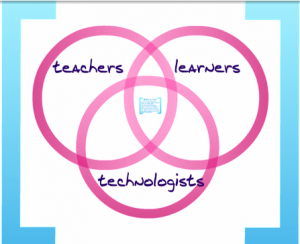West found that his students performed better on the Force Concepts Inventory, a test for honors physics students and first year college students on basic physics concepts when he used this technique. So far, nine other Bay Area teachers are trying Braincandy techniques on physical science, chemistry and biology students, and West is receiving help from Silicon Valley techies and business entrepreneurs to build out his site. The time is ripe for teachers to use their natural inclination to innovate to help the kids that they are failing, he said.
“If I do more of the same and just do it better -- I’ve seen that trajectory, and I feel like I’ve gone as far as I can with that and I need to try something else,” West said. “Based on my experience and the luck of the draw, technology is my channel.”
Adam Bellow, another ed-tech entrepreneur, recently developed a Pinterest-like tool for teachers called eduClipper. Bellow is based in New York and has spent much of his career helping teachers use technology in the classroom more effectively.
“The biggest issue that we have as teachers is finding and sharing good stuff,” Bellow said. “You have teachers that are open to doing these things, that want to, but who don’t necessarily know where to go or don’t feel they have a time to find them.” He wants eduClipper to fill that void and for students and teachers to interact on the site, sharing the buckets of useful links, videos and infographics with one another. Students could even use the site as way to develop a digital portfolio, he said.
Bellow built the tool to serve a need he found distinctly lacking. “The reason I’m building this tool is that I’ve seen so many companies build websites that they think are cool, or that they think address a need, without consulting teachers. Teachers are usually the last people to be consulted on many of these education technology companies,” Bellow said.
The site has already drawn 25,000 users and he actually isn’t accepting more until he rolls out the next version of the site. Beyond just helping teachers, Bellow is most excited about features directed at students and meant to encourage them to create. He wants eduClipper “to have students inspire other students to make real things,” the way that the Maker Faire events have done. With a body of work to carry with them, students would be able to show achievement through more than just testing.

Digital Harbor Foundation
James Sanders, who worked as a teacher for many years, is another educator wading into entrepreneurship. For his day job, Sanders works as the Innovation Manger for KIPP, Bay Area Schools. But he's also partnered with Esther Wojcicki, a journalism teacher at Palo Alto High, and Duncan Winter, to create ClassBadges, scheduled to launch Monday. It’s a digital platform for teachers and students to collect badges for mastery of certain topics. The badges represent learning experiences both inside and outside the classroom. For example, a student could get a badge for going to a museum and completing an exercise related to the visit. Sanders sees ClassBadges as a way for students to look back at a digital record of what they learned – plus it’s fun and uses elements of gamification that students are already accustomed to.
Sanders agreed with both Bellows and West that education is at a crossroads. “Everyone agrees this is finally a time where people are opening up to the idea of change in the classroom and the power of technology,” said Sanders. “People recognize that this is a powerful tool for learning.”
Educators are taking advantage of the moment, and the flurry of investor interest in ed-tech, to leverage some of their innovations into products. Here are some other educator-initiated companies and non-profits:
- ClassDojo: This free online tool, co-founded by teacher Sam Chaudhary, helps teachers manage behavior in the classroom by awarding points to students for positive behavior. Students get immediate feedback on their behavior, tied to a points system, which helps reinforce good behavior over time.
- Digital Harbor Foundation: This non-profit, cofounded by educator Shelly Blake-Plock, was started by educators in Baltimore to connect teachers, students and technologists to one another through the web. They want to foster innovation and entrepreneurship in students before they even graduate. For example, they have a reverse mentoring club where students teach older members of the community about technology. Or a STEM club, where students interested in science, technology, engineering and math are given real world challenges posed by industry leaders.
- Socrative: This web tool was built by a team of educators, engineers and entrepreneurs with the goal of increasing engagement and decreasing grading time. Through smart phones, laptops or tablets students enter digital classrooms where the teacher can control the flow of activities and games – getting an instant understanding of whether the students are grasping certain concepts. The tool can then analyze individual and class progress
- NoRedInk: Jeff Scheur started this company after three years teaching in Chicago schools. As an English teacher he spent hours grading papers only to have students ignore the feedback they received. NoRedInk uses material that is engaging to students, like their own conversations or their favorite TV shows to try to engage them in the question. As students answer questions the material adapts to how they are doing, drilling down on the underlying concepts as they progress through the activities. Teachers can track student progress and give assignments and quizzes tailored to each student’s interests. The hope is that NoRedInk makes grammar fun, so students will practice more than what is assigned to them.
These are just a few educators who've launched their own businesses in the education field. Who are others we should include? Let us know!



